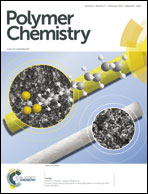Photo-induced helix–helix transition of a polystyrene derivative†
Abstract
Poly(2,5-bis[4-((S)-2-methylbutyloxy)phenyl]styrene) having a helical conformation underwent helix–helix transition upon photo-irradiation. Conformational transition can significantly alter polymer properties, and so far thermal stereomutation has been studied. However, as for photo-induced mutation, only helix–helix transition (irreversible CD-active to CD-silent helix transition) of a polyacrylate has been explored. Here, we present mutation of the polystyrene derivative. Chiroptical, viscometric, and vibrational spectroscopic analyses indicated the polymer mutated from an optically active helix to another optically inactive helix with a different shape.


 Please wait while we load your content...
Please wait while we load your content...